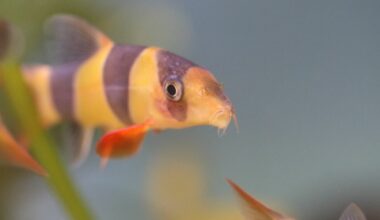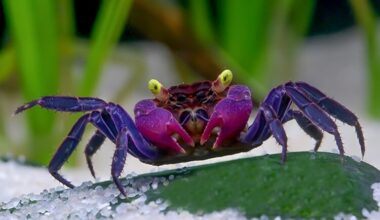The Chevron Tang is a stunning fish species that is popular among aquarium enthusiasts. These fish are known for their vibrant coloration especially in the juvenile stage since they change colors as they age. They have a distinctive pattern, featuring diagonal lines that resemble a chevron.
While they can be challenging to care for, with the right setup and attention, they can thrive in a home aquarium. We hope this care guide provides you with with everything you need to succeed as a new Chevron Tang owner, enjoy!
Table of Contents
Species Summary
Chevron Tangs are a relatively rare species and one of the more passive members of the Surgeonfish family. Known scientifically as Ctenochaetus hawaiiensis, these fish are native to the central Pacific Ocean, especially the waters surrounding Hawaii. They are herbivores who provide valuable cleanup services in your tank.
Chevrons, also called Chevys and Black Surgeonfish, reach depths 200 feet below the surface and live across different ranges of reefs throughout their lives. Young Chevrons stick to deeper areas among coral, while adults inhabit rockier regions closer to the surface.
These Tangs begin life as loners before spending their adulthood in bonded pairs or small groups. It is relatively rare for divers to spot them due to the depths juveniles prefer and adults’ excellent natural camouflage.
The species is moderately active, feeding on algae found across their reef home. Chevrons are unique tank inhabitants who undergo radical shifts in appearance as they age while happily coexisting with other peaceful fish. They are ideal for community tanks because their muted colors brilliantly contrast their flashier tank mates.
Appearance
Chevrons differ from many fish species because their colors become duller and darker as they age. Juvenile Chevrons are brilliant red-orange shades with a network of blue or purplish nesting V-shapes across their bodies that form lines, giving them the Chevron nickname. Adults are black with a network of green V-shapes that are only perceptible up close. The color change starts once the young fish reaches about 3 inches.
Author Note: This shift is related to defense. Young Chevrons live and feed among corals. Bright coloration allows them better camouflage. As they age, Chevrons transition to life among the rockier areas of the reefs. Darker tones mask them better. These Tangs are peaceful, making effective camouflage vital. Male and female Chevron Tangs are indistinguishable.
Chevron Tangs have flat, disc-shaped bodies characteristic of Surgeonfish. Their dorsal fin runs from the head to the caudal, and they have trademark spikes emerging from the peduncle. Their snouts are short and stubby, creating an almost pouty expression. This feature helps them use their 30 teeth to scrape and turn up algae.

Lifespan
With proper care and optimal tank conditions, Chevron Tangs can have a lifespan of up to 15 years.
Average Size
In adulthood, a Chevron Tang can reach an average size of 11 inches or 28 cm
Chevron Tang Care
Chevrons have many of the same quirks as other Tangs, including susceptibility to illness and intolerance for members of their species. However, these fish are one of the easier to care for Tangs and adapt well to tank life.
Tank Size
Experts recommend a minimum tank size of 150 gallons for a Chevron Tang. They are natural grazers who need space to swim and search for the algae they crave. These fish do best with a 4-foot or longer tank.
Water Parameters
- Water temperature: 73 to 80°F
- pH levels: 8.1 to 8.4
- Water hardness: 8 to 12 dKH
- Specific gravity: 1.020-1.025
Tank Setup
The tank should feature live rock and sand. These formations create optimal conditions for your Chevron’s food sources to grow. Space the rock far enough apart to provide the fish with crevices to escape into when feeling shy or intimidated but close enough to permit adequate open space for the fish to swim unrestricted.

Filtration
The tank needs a filter capable of handling the large water volume Chevrons require. Equally important, you must invest in a powerhead to create a strong current within your setup. Wild Chevrons seek out the surge areas of reefs. Your Chevron will thrive in the oxygen-rich water resulting from high water movement.
Acclimation
As with all fish, Chevron Tangs should be adapted to their home tank using the slow drip method. They are relatively hardy and ship well but are highly prone to disease. All specimens are wild-caught. As a result, it is essential to quarantine and monitor your Chevron for illness before introducing them to your aquarium.
Are Chevron Tangs Reef-Safe?
Yes, luckily your Chevron Tang is reef safe! They voraciously comb your tank for algae without harming coral polyps or other invertebrates that make up the reef. Their craving for diatom and green hair algae helps keep your tank clean and reef healthy.
Common Possible Diseases & Prevention
Like many saltwater species, these Chevron Tangs are susceptible to Marine Ich because they lack a mucus coating. The illness results from parasites. You can spot Marine Ich from the white splotches it creates on the fish’s body and fins. The infection causes fatigue and labored breathing.
When you recognize the disease, it’s best to evaluate the water conditions and restore them to optimal levels as quickly as possible. You can also begin treatment with anti-parasitic medication and monitor your fish. The earlier you catch the infection, the greater your Chevron’s chance to fully recover.
Author Note: Disease prevention hinges on maintaining proper tank conditions, actively monitoring water quality, and keeping your fish content. Stress and malnourishment are the most significant contributors to fish disease.
Food & Diet
Chevrons are herbivores who eat smaller algae than most other Tangs who prefer filamentous algae. Your fish will scour your tank, combing for microorganisms and plant material with its brush-like teeth. They are nicknamed Bristletooth Tangs for this unique anatomy and feeding method.
You can offer them chopped aquatic plant matter and nori seaweed to supplement their diet. Dried plant-based foods or flakes are acceptable options.
Author Note: Experts also recommend providing occasional meaty foods like mysis shrimp and baby brine shrimp to promote nutrition and fortify the fish.
It’s best to feed your Chevron two or three times daily by offering smaller portions and monitoring to ensure it eats. Only provide protein meals two times per week. Varying their diet keeps the fish engaged with feedings and ensures they meet their nutritional and caloric needs.
Behavior & Temperament
Chevrons are more peaceful than their fellow Tangs. While territorial with members of their species, they are docile and live peacefully with other species. Unfortunately, their laid-back nature makes them susceptible to bullying. Chevrons are active swimmers, and you’ll observe them exploring the rocks and sandy substrate for detritus and microalgae.
Their mouths contain rows of teeth that form comb-like filters. You’ll likely be able to spot their lip marks on the walls of your tank or anywhere else they find algae. However, their mouths are not strong enough to damage the tank.
Chevron Tang Tank Mates
Chevrons get along well with most other peaceful reef fish who can tolerate strong currents. It’s best to avoid aggressive and predatory fish, who can easily intimidate these passive inhabitants. Great options include:
- Blennies (like the Lawnmower Blenny or the Bicolor Blenny)
- Cleaner Shrimp
- Neon Gobies
- Sailfin Tangs (and other Tangs the Zebrasoma genus)
Breeding
Biologists believe wild Chevron Tangs spawn in mated pairs. Successful captive breeding has not yet occurred. As a result, all Chevrons available for purchase are wild-caught.
The tank-size requirements, difficulty establishing a mixed-sex pair of Chevrons, and odds of successfully isolating fertilized eggs make captive breeding unrealistic in a home setup.

Conclusion
Caring for a Chevron Tang can be a rewarding experience for aquarium enthusiasts. They require a carefully curated environment and a diet that mimics their natural habitat. It is essential to maintain excellent water quality and provide plenty of space for these fish to thrive. With proper care and attention, your Chevron Tang can provide years of enjoyment and beauty in your home aquarium.
Feel free to reach out to us with any questions you might have or even to share your success stories! We wish you best of luck and we hope your saltwater aquarium looks awesome with the addition of this nice looking fish.

